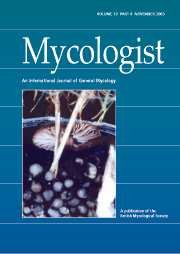Crossref Citations
This article has been cited by the following publications. This list is generated based on data provided by
Crossref.
Melin, Petter
Schnürer, Johan
and
Wagner, E. Gerhart H.
2004.
Disruption of the gene encoding the V-ATPase subunit A results in inhibition of normal growth and abolished sporulation in Aspergillus nidulans.
Microbiology,
Vol. 150,
Issue. 3,
p.
743.
Islam, Md. Tofazzal
2008.
Disruption of ultrastructure and cytoskeletal network is involved with biocontrol of damping-off pathogen Aphanomyces cochlioides by Lysobacter sp. strain SB-K88.
Biological Control,
Vol. 46,
Issue. 3,
p.
312.
Voyron, Samuele
Roussel, Sophie
Munaut, Françoise
Varese, Giovanna C.
Ginepro, Marco
Declerck, Stephan
and
Filipello Marchisio, Valeria
2009.
Vitality and genetic fidelity of white-rot fungi mycelia following different methods of preservation.
Mycological Research,
Vol. 113,
Issue. 10,
p.
1027.
Richards, Andrea
Veses, Veronica
and
Gow, Neil A.R.
2010.
Vacuole dynamics in fungi.
Fungal Biology Reviews,
Vol. 24,
Issue. 3-4,
p.
93.
Shoji, Jun-ya
and
Craven, Kelly D.
2011.
Autophagy in basal hyphal compartments: A green strategy of great recyclers.
Fungal Biology Reviews,
Vol. 25,
Issue. 2,
p.
79.
Richards, Andrea
Gow, Neil A.R.
and
Veses, Veronica
2012.
Identification of vacuole defects in fungi.
Journal of Microbiological Methods,
Vol. 91,
Issue. 1,
p.
155.
Diekmann, Yoan
and
Pereira-Leal, José B.
2013.
Evolution of intracellular compartmentalization.
Biochemical Journal,
Vol. 449,
Issue. 2,
p.
319.
Atsatt, Peter R.
Whiteside, Matthew D.
and
Vinatzer, Boris Alexander
2014.
Novel Symbiotic Protoplasts Formed by Endophytic Fungi Explain Their Hidden Existence, Lifestyle Switching, and Diversity within the Plant Kingdom.
PLoS ONE,
Vol. 9,
Issue. 4,
p.
e95266.
Ogar, Anna
Tylko, Grzegorz
and
Turnau, Katarzyna
2015.
Antifungal properties of silver nanoparticles against indoor mould growth.
Science of The Total Environment,
Vol. 521-522,
Issue. ,
p.
305.
Martin, William F.
Tielens, Aloysius G. M.
Mentel, Marek
Garg, Sriram G.
and
Gould, Sven B.
2017.
The Physiology of Phagocytosis in the Context of Mitochondrial Origin.
Microbiology and Molecular Biology Reviews,
Vol. 81,
Issue. 3,
Bui, Tri‐Thuc
Harting, Rebekka
Braus‐Stromeyer, Susanna A.
Tran, Van‐Tuan
Leonard, Miriam
Höfer, Annalena
Abelmann, Anja
Bakti, Fruzsina
Valerius, Oliver
Schlüter, Rabea
Stanley, Claire E.
Ambrósio, Alinne
and
Braus, Gerhard H.
2019.
Verticillium dahliae transcription factors Som1 and Vta3 control microsclerotia formation and sequential steps of plant root penetration and colonisation to induce disease.
New Phytologist,
Vol. 221,
Issue. 4,
p.
2138.
Li, Tao
Xiu, Qian
Zhang, Jie
Wang, Jian Xin
Duan, Ya Bing
and
Zhou, Ming Guo
2020.
Pharmacological Characteristics and Efficacy of Fluazinam AgainstCorynespora cassiicola, Causing Cucumber Target Spot in Greenhouses.
Plant Disease,
Vol. 104,
Issue. 9,
p.
2449.
Reuter-Weissenberger, Philipp
Meir, Juliane
Pérez, J. Christian
Rao, Reeta Prusty
and
Berman, Judith
2021.
A Fungal Transcription Regulator of Vacuolar Function Modulates Candida albicans Interactions with Host Epithelial Cells.
mBio,
Vol. 12,
Issue. 6,
Barros, Diana
Pradhan, Arunava
Pascoal, Cláudia
and
Cássio, Fernanda
2021.
Transcriptomics reveals the action mechanisms and cellular targets of citrate-coated silver nanoparticles in a ubiquitous aquatic fungus.
Environmental Pollution,
Vol. 268,
Issue. ,
p.
115913.
Trejo-Raya, Ariadna Berenice
Rodríguez-Romero, Víctor Manuel
Bautista-Baños, Silvia
Quiroz-Figueroa, Francisco Roberto
Villanueva-Arce, Ramón
and
Durán-Páramo, Enrique
2021.
Effective In Vitro Control of Two Phytopathogens of Agricultural Interest Using Cell-Free Extracts of Pseudomonas fluorescens and Chitosan.
Molecules,
Vol. 26,
Issue. 21,
p.
6359.
Baek, Sehyeon
Noh, Mi Young
Mun, Seulgi
Lee, Se Jin
Arakane, Yasuyuki
and
Kim, Jae Su
2022.
Ultrastructural analysis of beetle larva cuticles during infection with the entomopathogenic fungus, Beauveria bassiana.
Pest Management Science,
Vol. 78,
Issue. 8,
p.
3356.
Cai, Enping
Yan, Meixin
Sun, Xian
Zeng, Rong
Zheng, Wenqiang
Deng, Yizhen
Jiang, Zide
and
Chang, Changqing
2022.
Kinase Hog1 and Adr1 Opposingly Regulate Haploid Cell Morphology by Controlling Vacuole Size in Sporisorium scitamineum.
Journal of Fungi,
Vol. 8,
Issue. 8,
p.
865.
Yang, Xing
Guo, Cuimei
Chen, Chi
Hu, Zhijuan
Zheng, Xinyao
Xu, Shan
Yang, Xingyong
and
Xie, Chengjian
2022.
A Kinesin Vdkin2 Required for Vacuole Formation, Mycelium Growth, and Penetration Structure Formation of Verticillium dahliae.
Journal of Fungi,
Vol. 8,
Issue. 4,
p.
391.
Yang, Xing
Hu, Zhijuan
Yuan, Jingjie
Zou, Run
Wang, Yilan
Peng, Xuan
Xu, Shan
and
Xie, Chengjian
2023.
Functional Role of RING Ubiquitin E3 Ligase VdBre1 and VdHrd1 in the Pathogenicity and Penetration Structure Formation of Verticillium dahliae.
Journal of Fungi,
Vol. 9,
Issue. 10,
p.
1037.
Liu, Jie
Zhang, Jie
Yan, Huijuan
Yi, Tuyong
Shim, Won Bo
and
Zhou, Zehua
2024.
FvVam6 is associated with fungal development and fumonisin biosynthesis via vacuole morphology regulation in Fusarium verticillioides1.
Journal of Integrative Agriculture,


